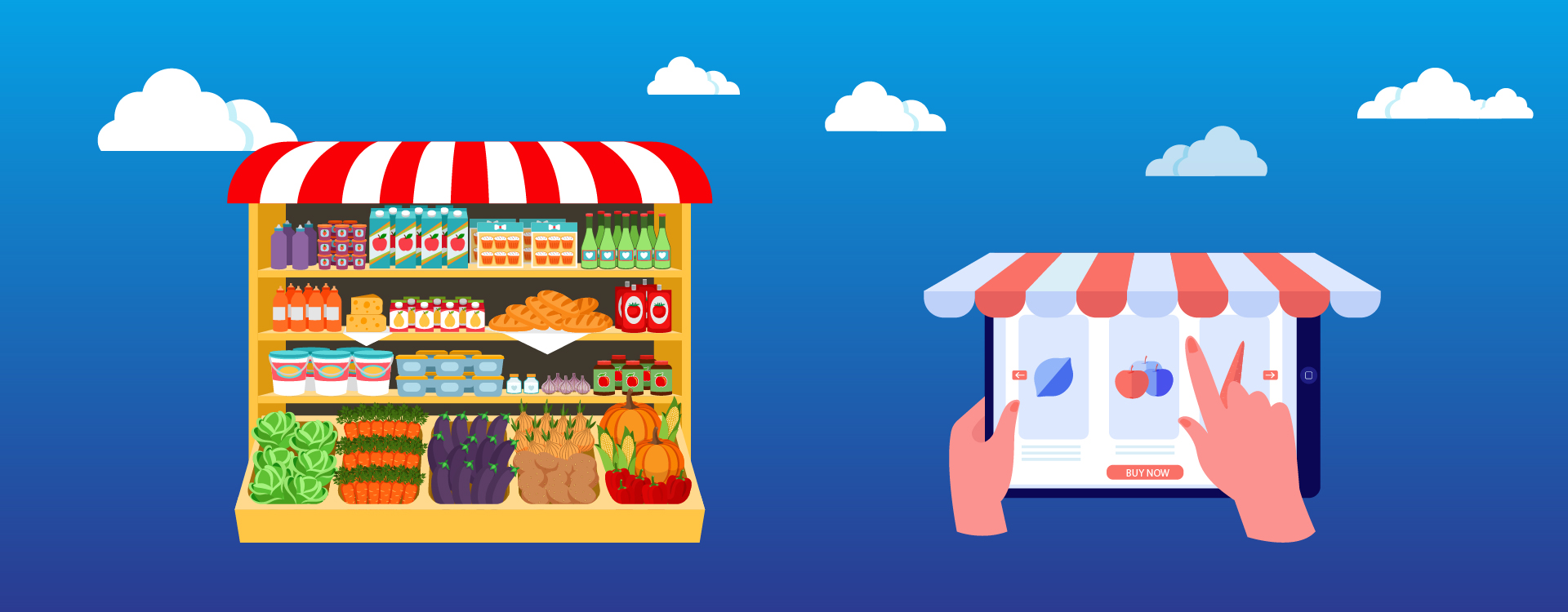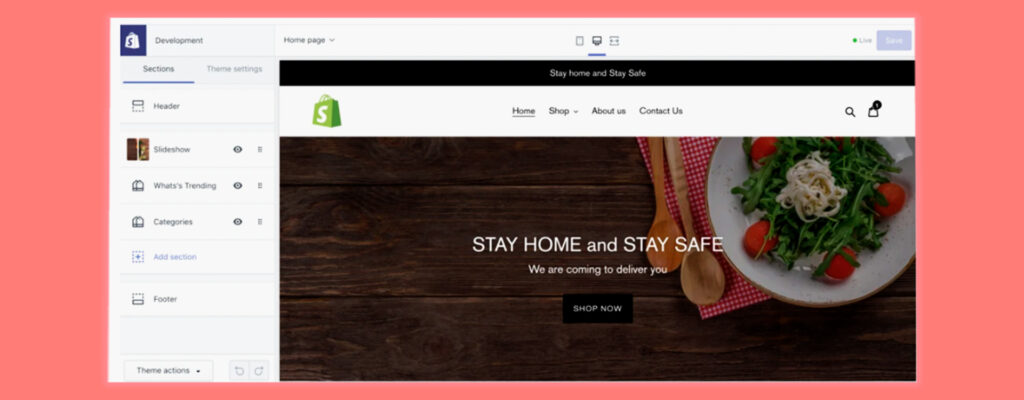Past one year, Google witnessed a 300 percent and 550 percent spike in searches like ‘ration dukaan near me’ and ‘grocery delivery near me’ respectively. From these two searches, it is evident that retail and grocery sale in India has undergone a paradigm shift and with the pandemic, the change has accelerated. With smartphones becoming ubiquitous in every hand, consumers are now a part of the exploration cycle that is greatly defined by the ‘always-on search’ habit aided by an abundance of information. With the rapid spread of infections in covid’s second wave, people are cautious to step out from their homes. In pre-covid times, people generally shopped at their neighbourhood grocery store or vendors, with lockdowns-imposed people’s dependence on online shopping has increased manifold. According to a report by JM Financial the online grocery delivery market witnessed a 30 percent month-on-month growth in monthly traffic in March 2021. E-grocery majors like Big Basket are seeing a twofold increase in daily orders currently as compared to pre-Covid times. In the future online retailing is set to pick up pace in India as social distancing becomes the new normal, which is where traditional retail and grocery stores are losing ground to e-grocery aggregators, further fuelling the battle of online vs offline retail. A crisis for the local grocery stores lurks in the corner since according to a joint study by Accenture and TRRAIN, at least 90,000 small provisions are likely to close by 2022 and 600 new modern stores will open. There will be 60000 new jobs created but nearly 3,00,00 jobs will be whitewashed. Grocery in India accounts for 66% of the total retail spend in India. Sensing the grocery sector to be an opportunity for food delivery apps Zomato and Swiggy partnered with local Kirana stores or neighbourhood stores and supermarkets to offer hyperlocal delivery of groceries, and essentials where they were already staring at the losses due to closed restaurants and hotels. Social e-commerce start-up Meesho, Paytm Mall, Snapdeal, Shopclues, and Bengaluru-based real estate operator No Broker too plunged into the online grocery space to sustain themselves. Jio Mart, Flipkart and Amazon are elbowing to occupy a larger section in retail’s profit pie by digitising India’s local retailers. Although the local retailers are digitising themselves through these platforms it has its shortcomings. With more players in the online grocery market, the players are offering deep discounts as a point of differentiation to attract more users but in the process, the local Kirana stores end up paying huge price commission, which is not profitable. In this highly digitally connected world, local retail stores now should ramp up their businesses online to become discoverable in Google searches.
‘‘
Google witnessed a 300 percent and 550 percent spike in searches like ‘ration dukaan near me’ and ‘grocery delivery near me’ respectively.
Trends to emerge in the online local retailers’ space
Going vocal for local
The government’s support schemes for the local shopkeepers and locally produced brands and products have made ‘vocal for local’ gain steam that is encouraging consumers to purchase from them. Besides these, procuring the local produce is emphasised since the lockdown-led restrictions have disrupted the supply chains causing a shortage of essentials from consumer brands.
A Phy-gital Kirana Store
Heightened concerns of contracting the virus are forcing shop owners to create touchless shopping experiences. Websites, WhatsApp groups, and digital payments are being adopted at a rapid pace by retail business owners. Increased usage of UPI and digital wallets has contributed to quicker digital adoption.
Buy Online Pickup in Store or Curbside Pickup
Buying things online and collecting the ready cart from the store is a trend that is expected to grow as people would like to avoid standing in long queues. A local retail store in digital avatar will have an easy way to catalogue products, conveniently order via WhatsApp, pay quickly digitally, and a digital discovery on Google. People will shift their grocery purchases from large e-commerce companies to hyperlocal stores if they succeed in giving convenience while shopping and will put up a tough fight against the e-commerce majors, who struggle with a large inventory, warehousing, logistics, marketing overheads, cold chain, and customer loyalty.
Personalised Grocery Shopping
Offering personalised grocery shopping means creating customised baskets so that the shopper does not need to go back and forth between different categories to add one product to their cart. These pre-loaded baskets make the product selections more efficient and ensure customers do not forget any essentials they need. With a ready basket, a customer only needs to add any additional products from a set of personalized recommendations or category pages and remove products they do not need at the moment.
How Shopify Can Help Build your Online Retail Store
The first step to create your online store with Shopify is to login with your email id to Shopify’s homepage and begin with the 90-day free trial. The store name will become the URL that will be used by the customers when they want to order from the store.
Before we begin selling online few things retail store owners should keep ready:
- Product names, available inventory quantity, and price
- Credit/Debit card to link with the store
- Payment gateway account to accept online payments. Shopify has tied up with Paytm and registering with it will get your account activated in no time.
Setting up the online store
We can design our online retail store using themes from Shopify. The themes from Shopify can be further customised by adding an announcement bar, banners, and category tiles images on the home page. For enabling customers to start shopping immediately, include a button with a call to action. For that click on the ‘All Products’ as the button link.
Setting up the menu navigation
While we are setting up the online store, we should think about how we navigate our customers to find their products and information about the business. To make the online store look systematic and less confusing, similarly to an offline store with well-stacked goods, we need the product categories and sub-categories in the menu bar so that customers can find products with ease and navigate the website.
Adding the products in the online store
Products can be added to the online store either manually or by directly uploading products from an excel sheet. We need to head on to ‘Product’ and click ‘All Products’. After clicking we add the product title, description, and photo. If your products have more than one option in terms of different sizes and colours then make sure to edit variants. For shops offering pick-up at the store, they should not select the shipping option and not forget to select the ‘Track Inventory’. The online store should be kept simple by adding those products or essentials that are high in demand.
Creating the product categories
The products uploaded can be grouped into collections to make it easier to find them by category. Here are few examples of collections that we can create:
- Citrus Fruits
- Organic Vegetables
- Dairy Food products
- Meat and Poultry products
After we create a collection, it will be shown on the online store as a webpage with a gallery of the products. The customers can then click a product image on the collection page to visit a specific product page. In this way, we can navigate the customer to find and view products through proper sorting. We can also organise the products on the website by using the ‘Smart Collections’ feature which groups products basis the conditions that we provide for example: to create a smart collection of mangoes which are Rs 120 per kg and above it will automatically gather all the mangoes belonging to this price range to create the ‘Summer Mango Mania’ collection.
‘‘
Grocery in India accounts for 66% of the total retail spend in India.
Setting up the local delivery for online orders
We can set up the option for local customers to have their orders delivered. For local deliveries, we can enable the local delivery option for each location that retailers will offer delivery from. If a customer’s address is within the delivery area, then the customer will get to click local delivery as an option at checkout. To choose a delivery radius, we can include several local regions by enabling neighbouring regions.
Fulfilling the local delivery orders
Local delivery orders of online retail businesses can be managed by Shopify tools:
- Shopify Admin and Shopify for Mobile: From Shopify, we get the information of the local delivery workflows and processes of unfulfilled to delivered orders, filter and print orders, check delivery instructions and locations, and update order statuses.
- Shopify POS: From Shopify POS, retail owners can view and filter local delivery orders, print delivery slips, and update order statuses.
- Shopify Local Delivery App: Shopify’s local delivery app helps to create delivery order lists, map delivery locations, and optimise delivery routes. Once an order is delivered, through the app the order status can be updated.
What Is in it for the local retailers?
The retail vertical is undergoing a digital evolution. Hyperlocal retail shops having an online presence will help customers discover the closest retail shops to their homes and enable convenient ordering. Digitisation in small-medium-sized retail businesses will empower them to survive the lockdown menace and serve the customers well. Even though conglomerates and several e-commerce majors are acting as a mediator to onboard local retailers to their platforms, a significant chunk of commission is paid to them leaving them with less revenue, therefore it is advisable to own your website with Shopify for hyperlocal deliveries and build better loyalty with customers.





